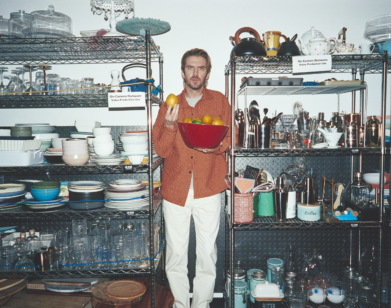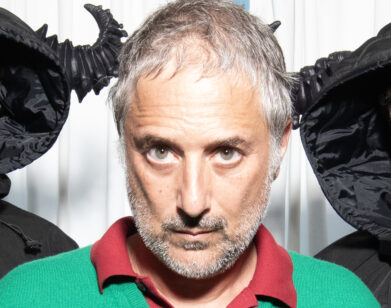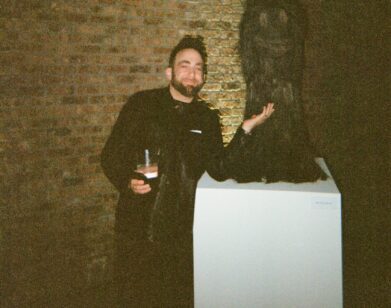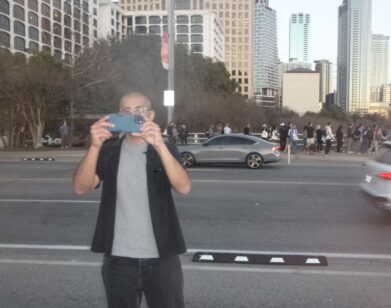Jonas Mekas
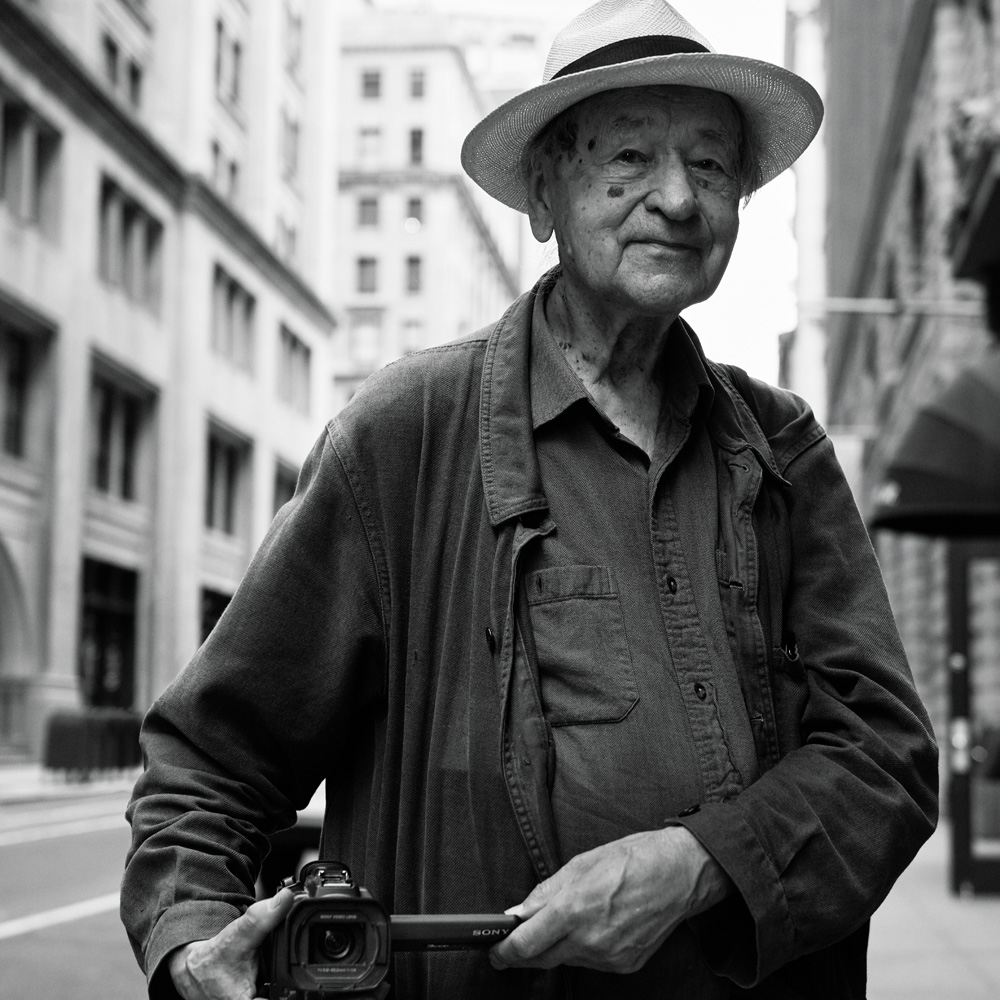
JONAS MEKAS IN NEW YORK, JULY 2015. ALL CLOTHING: MEKAS’S OWN.
I never did anything because I was ‘interested’ in it, but from a certain kind of compulsion. Obsession. Passion for something that pulls me into it. Jonas Mekas
We often talk, a bit blithely, about art as a place, a haven. We talk about artists as exiles, as extra-societal scouts or even outcasts, living on the margins, out there, on the periphery. We may even think of the work they do there as a kind of map-making, charting pathways deeper, further, higher, elsewhere. But what of real exiles, displaced from their actual homes, what kind of haven can they make in the land of art? What pathways can they find or make there?
For more than half a century, Jonas Mekas has been one of the great architects in that hinterland, building, with his widely celebrated poetry, criticism, and legendary film work, the only place he can rightly call home. After leaving the farm where he grew up in Lithuania when he was 22 years old, Mekas migrated through various purgatories—including work camps and refugee camps in Germany—until he finally made it to New York. Once there, he started to build a community of artists and thinkers that would change, at the very least, film and criticism forever, and build his own body of work. When censorship in the ’60s threatened to create elisions in the films being presented, Mekas began work on the Anthology Film Archives, which opened in 1970, and remains a bulwark against the encroachments made by digitization and general neglect, as Mekas remains among cinema’s greatest archivists.
Through it all, through the terror of war, through a treacherous immigration, through the general decay of friendships, of film celluloid, and especially of our cultural memory, Mekas’s greatest mission has always been to bear witness.
“I see Jonas as an active participant,” Martin Scorsese told me, “preserving not just memories, but freedom—his own freedom and the freedom of his fellow filmmakers and writers. With his films, Jonas has given us a direct personal response to the world, keeping the direct contact between his camera and the moment preserved.” And by preserving those moments, mundane in real time, maybe, but legendary later (of Stan Brakhage crashing on his couch, say, or logging the minutes as Andy Warhol and Allen Ginsberg visited his loft, workshopping their various artistic credos with one another or making a short film every day for an entire year in 2007), Mekas has built an incredible testament to his life and times. “As a critic at The Voice and a founder of Film Culture, Jonas went a long way toward redefining cinema,” Scorsese said. “And as the founder of Anthology Film Archives, he created a haven, a refuge for filmmakers and their films, a place for cinema.”In November, Spector Books, Leipzig will release nearly 50 years of Mekas’s diaries as Scrapbook of the Sixties: Writings 1958 – 2010, giving us all access to this treasure trove and making witnesses of us all. To celebrate the occasion, Mekas’s longtime friend, the great filmmaker Peter Bogdanovich, rang him up to talk about the old times—but more importantly, the here and now. —Chris Wallace
JONAS MEKAS: Hello, hello! Where are you?
PETER BOGDANOVICH: I’m in Beverly Hills, staying at a friend’s house. And I’m waiting for my new film to come out in August.
MEKAS: Ah, good. It’s about time that we see a new film by Peter Bogdanovich.
BOGDANOVICH: Well, thank you. It’s called She’s Funny That Way. It’s a kind of screwball comedy about the theater.
MEKAS: Well, we met, actually, in the theater. That’s what brought us together. I went upstate to see your production of … was it the Tennessee Williams?
BOGDANOVICH: Yes, you’re right. You have a good memory. It was Camino Real, a wonderful play of Tennessee’s. I’d forgotten that that’s where we met.
MEKAS: The New Yorker Theater times, where we spent a lot of time when you did the programming there. We had so many nights upstairs with Emile de Antonio and Dan Talbot, in the early ’60s. And then, of course, we got more involved because of Film Culture, which I was editing and wanted you to write for. You did a lot of good writing. Are you still writing? Your writing somehow always went together with your filmmaking and your television work—all the biographies of filmmakers.
BOGDANOVICH: I have a new book that I may publish. I’m not sure about it because a lot of people are still alive. Well, it’s a diary book. I kept a diary from the middle of ’65 to the middle of ’71. And that was a very big period for me because I went to California and I got into pictures. And it’s a good book, but I’m worried about some of the people being insulted by it.
MEKAS: [laughs] That is always a challenge, yes. I am publishing almost 50 years of my diaries.
BOGDANOVICH: Wow.
MEKAS: They begin in the ’50s and end in the year 2000. When I had my video camera in the ’90s, I somehow phased out the written diaries. The video replaced my written diaries. You appear in my video diaries. And, of course, you appear in my written diaries, too. [laughs]
BOGDANOVICH: You have a fascinating life. Where were you when the Soviets invaded Lithuania?
MEKAS: When we noticed the tanks and truckloads of soldiers on our dusty small village road, I grabbed my camera and ran—I was a farmer boy—my older brothers had just given me my first still camera, so I thought, “Oh, this is fantastic. Some of my first images will be of those trucks full of soldiers on a dusty village road entering Lithuania.” I ran to the road and snapped the first picture in my life. And one of the Russian soldiers comes running to me, grabs the camera out of my hands, rips out the film, throws it into the dust of the road, rubs it in with his boot, points a finger to the house and shouts, “Run, you stupid boy! Run home before anything else happens to you.”
BOGDANOVICH: How old were you?
MEKAS: 14, 15. Something like that.
BOGDANOVICH: It didn’t discourage you, though, obviously.
MEKAS: You see, on a farm, there is no money, no income. We couldn’t afford to take snaps, like, wildly. You’d wait for special occasions to take a picture. When I graduated the fourth grade, our teacher took all of us to the city to see a movie. The city was about 15 miles from the village, but I had never seen a movie before. It was some kind of American melodrama, and a Mickey Mouse cartoon. I don’t remember the melodrama. I still remember the Mickey Mouse cartoon. [both laugh]
BOGDANOVICH: And you joined the resistance in 1941, is that correct?
MEKAS: Yes. When the Germans came in, I joined other young people in the resistance. My function was to do the typing for the underground newspaper. It was against the Germans and the Soviets.
BOGDANOVICH: You and Adolfas?
MEKAS: I was more than two years older and already in high school. I was in the city, and he was still in the village on the farm. Actually, I don’t think he knew about my involvement at the time. I could not tell him. I could not tell anybody. It had to be very, very secret. But my work with the underground was the reason why I ended up in the West. My typewriter was stolen and I could not take chances that it would be discovered by the German police because they were searching for typeface that would match that. I was advised to disappear, the further the better. So I persuaded my brother Adolfas to join me. We were very close, so he felt that he had to go with me. And we boarded a train for Vienna to go to the University of Vienna, but on our way there, the German military police got us and sent us to a forced labor camp near Hamburg. And that’s where we spent the last year of war.
BOGDANOVICH: I heard you escaped.
MEKAS: We managed to escape, and we thought that if we could get to Denmark and from Denmark maybe to Sweden … But it was all a pipe dream. We ended up on a German farm together with some German refugees, and that’s where the end of war found us. What followed was five years of displaced-person camps. Like the refugees that you have now in Lebanon and all those other places—all those millions of refugees, homeless. Our situation was very similar to that. And, then, on October 29, 1949, the United Nations International Refugee Organization brought us to New York. I was 27. And that’s when I decided to remain 27.
BOGDANOVICH: [laughs] Were your parents still alive?
MEKAS: They were. We did not know, though, at that time. We connected, like, ten years later. It was not possible to write. They didn’t know what happened to us, and we did not know what the situation was there. Those were very hard days.
BOGDANOVICH: Were you always interested in art?
MEKAS: I did a lot of reading, and I began keeping a diary when I was about 6 years old. Not a written diary; I learned to write comparatively late, but I made a diary of drawings. But those drawings are all gone. When I had to leave Lithuania, I buried everything in the ground, and it’s all rotten now, of course. I began writing poetry when I was about 10. Bad poetry, but you start with bad poetry. [laughs]
BOGDANOVICH: How did the hardships of the war affect you?
MEKAS: One result is that I missed my teenage years. I was never a teenager. There is a big hole there, and then it’s in New York where my life begins. But forced uprootedness is not the same as when you leave home on your own, seeking luck or adventure abroad. An adventurer can always return home; an exile cannot. So I decided that my home would be culture. But the deeper I went into culture, the more confused I got. So I needed something more real. I said, “Okay, from now on, my country will be cinema.” But an exile is still never at home. I will always be split. I’m not schizophrenic. I am not two parts; I’m split into, like, seven parts. There was a time, maybe, I was in, like, 100 parts. I managed somehow to put them together—thanks to New York and to my new friends, including you. But I will never be able to put myself back together completely. I am still Lithuanian. My early life is poetry, Lithuanian poetry. It never really disappears. And now I am here in New York, and I go to Paris and I feel like, “Oh, maybe I should live in Paris.” When I lived in Manhattan, I looked west, to New Jersey, across the Hudson River, toward California. Where I am now in Brooklyn, I seem to look east. I’m very happy in Brooklyn; it is much more alive than Manhattan. But at the same time, Brooklyn is not exactly America. [laughs] When I first came to New York, I came to Williamsburg, which was very poor and miserable in those days. Like all immigrants, I stayed around there for a couple of years, earning my bread by taking any job I found, but then I had to run. I had to run to Manhattan. I ended up on Orchard Street, and that’s where my real New York life began. At some point I ended up in a place called Graphic studios, doing photographic work, working with huge cameras. Actually, we did work for the international edition of Life magazine. As soon as I moved to Orchard Street, I met Jackson Mac Low, LeRoi Jones, and Allen Ginsberg. It was very simple, you went to poetry readings, to film screenings, to theater, and you met people—especially when you’re ready for anything, any excitement. I was starved for culture. Adolfas and I would go to theater or movies every evening. We didn’t miss any new opening, be it ballet or theater or movie or poetry readings at the 92nd Street Y. It was amazing. Or you could go to the White Horse Tavern, where Robert Flaherty and Dylan Thomas were holding court. Yoko Ono, I met through George Maciunas, the father of the Fluxus movement, whom I met when he was 17. I met Yoko in ’61 or ’62, I think. She was already holding her own court in her loft on Chambers Street. I helped her during her first show at AG Gallery on Madison by the old Whitney Museum. And we became friends. I gave her her first job in America, at Film Culture, so she could stay in the States. We’re still friends. I also met Maya Deren very early on. That was in the spring of ’53. I visited her because I could not find her little book, An Anagram of Ideas on Art, Form and Film. I’d heard a lot about her essay, but I could not find it anywhere, so I called her and she said, “Come, I will give you one.” That’s how I met Maya Deren. And we became good friends.
BOGDANOVICH: And when did you meet Dalí?
MEKAS: [laughs] That was in ’63. I was already on 414 Park Avenue South. That was my apartment and the headquarters of the Film-Makers’ Cooperative, which became a very busy place, a meeting place for filmmakers, poets. You’d see Robert Frank and Ginsberg and Barbara Rubin, Kenneth Anger, Harry Smith, Larry Rivers, painters … And one evening, there was Salvador Dalí. He was a very curious person and was interested in what was happening in this so-called underground at that time. And that’s when he met some of the people that he used later in some of his own “happenings.” Of course, Andy Warhol also came and met all the filmmakers and some of his future superstars. He wasn’t so well known yet. That’s where he met Jack Smith and Mario Montez and Taylor Mead, etcetera. And then he decided to make a movie himself.
BOGDANOVICH: You became friends with Jackie Kennedy around that time, didn’t you?
MEKAS: What we are doing here is dropping names. [laughs] All those names. By chance, the fates led me to many of those people—people who are very famous. It’s just how it happened, I don’t know. But as far as Jackie, she needed somebody to tutor her children in cinema and photography. Peter Beard was tutoring them in art history, and when Jackie asked who could help to introduce them to cinema and photography, he said, “Oh, I know the person—Jonas!” So we spent a lot of time, in New York and Montauk. They spent their summers at Andy Warhol’s estate in Montauk—well, an old house and some shacks around the house—the children used to spend a lot of time during the summer there. So we both, with Peter, kept them company and, unofficially, performed the duties of bodyguard.
BOGDANOVICH: And then you started Film Culture, in ’54?
MEKAS: The first issue came out in December ’54.
BOGDANOVICH: That magazine was quite revolutionary, wasn’t it?
MEKAS: There really was nothing else at that time. In Paris there was Cahiers du cinéma; in England there was Sight & Sound. There was nothing in the United States. So Film Culture was the only serious publication dedicated to cinema. We managed to get some very exciting young writers with new and exciting points of view and ideas about cinema, about the history of cinema and where cinema was at that time. Andrew Sarris brought his friend Eugene Archer who later went to The New York Times. And Arlene Croce, before she went to The New Yorker. And, of course, Andrew went to The Village Voice. I began my Voice column, “Movie Journal,” in’58. But around 1960 or ’61, New York was so busy already—I couldn’t cover everything that was happening. So I brought in Andrew Sarris to cover the more public cinema, or what they call commercial cinema, and I restricted myself to the independent productions.
BOGDANOVICH: So that’s how you met [John] Cassavetes?
MEKAS: Yes, I met him during the shooting of Shadows. Actually, I met him during the screening of Shadows, but later we became friends during the reshooting of Shadows. It’s a long story but there are two versions of Shadows [1957 and 1959].
BOGDANOVICH: Yes, the first version, which you liked, and the second version you didn’t like as much.
MEKAS: The first version was more open, more like a jazz piece, and the second one was more carefully structured and closer to what he was doing later. I would have liked him to continue in that more open kind of style. But Shadows was, for him, like school, like an exercise for what he did later.
BOGDANOVICH: Did you like his films later?
MEKAS: I like his work very much. Unique. You cannot compare him with any other filmmaker.
BOGDANOVICH: Was Film Culture successful?
MEKAS: I think it created enough discussion and enough interest, and it produced an entire generation of writers. It did what we wanted it to do, I guess. It was hard work. I had to work at Graphic studios because I needed money to pay the printer. Everything I earned went into the magazine.
BOGDANOVICH: And then you opened the Film-makers’ Cinematheque, which eventually became the Anthology Film Archives.
MEKAS: That was in ’64. In the spring of ’64, I ran into problems with the police because there was a law requiring that every film presented publicly should be licensed, and I was against it. I felt films shouldn’t need to be licensed, shouldn’t go through the committees that can decide what should be cut, what can be left in. And that happened to too many films. So I refused to do it, and that’s where I clashed with the police—for screening Flaming Creatures [1963], a Jack Smith film, and Jean Genet’s Un chant d’amour [1950]. I screened them without licensing, so I was arrested. I got six months of suspended sentence. But it provoked discussion that sped the abandoning of licensing. The censorship affected other areas, like performances. Lenny Bruce had problems around the same time. It took a few more years, but by the time I opened Anthology Film Archives, in December 1970, in Joe Papp’s building, 425 Lafayette, the licensing of films was gone.
BOGDANOVICH: I didn’t know anything about all this, about your adventures, like you shooting Andy Warhol’s film Empire [1964].
MEKAS: I think that was in ’64 maybe? Yes, I was the cameraman on that one. It was shot just facing straight at the Empire State Building, through the window from the 41st floor of the Time-Life Building. So I set up the camera, I framed it, and it took all night, but we did it. But during this whole time, when I was editing Film Culture and running Filmmakers’ Cinematheque and starting Anthology, I was also making my films. And, of course, I was writing, which is continuing. But as of 15 years ago, with me focusing on video and embracing the digital, I am completely somewhere else: installation art, multiple projections and monitors, etcetera. But that’s why—that past that we were just talking about, it’s history—but to me it’s boring. It’s enough. It has been written about enough!
BOGDANOVICH: I understand. Let’s talk about where you are now.
MEKAS: Right now, I just came back from Venice, where I had exhibitions in two different places. One of them, “The Internet Saga,” is at the only Burger King in Venice. It’s a Burger King, but it’s a palace. [both laugh] Somebody referred to it as a cathedral, because I put frames from my films, colored frames in transparencies. I covered all the windows, and inside I have several different screens running constantly with different images that are from different video cycles. It’s a busy place. At the same time, there are some people eating hamburgers. It’s a simple people’s place. And a few canals further, there’s the official Venice art Biennale sponsored by ministries of culture and very expensive, million-dollar boring installations—whereas mine cost only a few thousand. And just before that, I had a show in Karlsruhe, in Germany, with 52 monitors running my 365—day project where, in 2007, I made a film every day and put it on my website. On 52 monitors, running simultaneously, it was like a symphony of images. So that’s what I’m doing, and that’s what makes me excited.
BOGDANOVICH: Do you think that the relative inexpensiveness of digital equipment to make a movie is helpful?
MEKAS: Yes. Even for the very commercially minded films telling some very complicated, big, monumental story, they do it digitally. But also you can use less-complicated digital technology, just little cameras that you can carry in your pocket, to find more personal subjects and personal approaches. Just as in writing, there are novelistic and sort of pedestrian ways of telling a story, to write a postcard with your little pocket camera and put it on websites. I think that’s where the most exciting kind of imagery and content is being recorded and exchanged today.
BOGDANOVICH: Since you have worked in a variety of mediums, is there some way that you can define what your artistic practice is? What continues to interest you in terms of subject matter?
MEKAS: I never did anything because I was “interested” in it, but from a certain kind of compulsion. Obsession. Passion for something that pulls me into it. So I am pulled into different media. I cannot resist. Maybe it is a sickness. I have to do it and exchange that with friends. And what we want to record today, it can only be recorded with the newest, most up-to-date technology; it cannot be recorded any more with the old technologies. So I use what’s available, the technology that helps me to do what I want to do. I think if I would ask you why you do what you do, Peter, you would have the same difficulty—you just have to do it. Otherwise you would have a nervous breakdown. [laughs]
BOGDANOVICH: Exactly. That’s true.
MEKAS: On the other hand, I don’t trust people, artists, who never have a nervous breakdown. [Bogdanovich laughs] Because a certain kind of sensitivity is needed for an artist—be it a musician, a dancer, a filmmaker, or the poet. We don’t lead normal lives. We don’t think normally. We don’t feel normally. We are not normal in that sense.
BOGDANOVICH: I’ve always thought of you as a revolutionary, Jonas.
MEKAS: [laughs] They called my Venice show a manifesto. Like a protest, in a way.
BOGDANOVICH: Definitely.
MEKAS: But that was done as a normal thing, without thinking. It’s just following what one’s feeling. That’s how it has to be done.
BOGDANOVICH: I look at the titles of your films, like Reminiscences of a Journey to Lithuania [1972] or Lost, Lost, Lost [1976] or As I Was Moving Ahead Occasionally I Saw Brief Glimpses of Beauty [2000]. They all have a kind of sadness to them.
MEKAS: I’m not so sure there is much sadness there, but sadness is a very necessary feeling—state of human experience. Sadness means … I don’t know, I’ve never thought how to really describe what is sadness. Not so easy to describe.
BOGDANOVICH: Well, a lot of your films are dealing with memories, no?
MEKAS: I’m not so sure my work is about memories. My films are the celebration of reality, of life, of my friends, of actual daily life that passes and is gone tomorrow. We don’t pay attention to it when it happens. Later, or course, we look back, we remember. But, for me, to catch, to celebrate the reality and life and friends and everything around me the very moment it happens—that’s what is, that’s what I’m possessed by.
BOGDANOVICH: I remember Adolfas wrote a script called Hallelujah the Hills back in the late ’50s, early ’60s, and he wanted me to be in it, and I rejected it because I didn’t want to be running around without clothes on. [laughs]
MEKAS: And in the snow … Peter Beard ultimately did it. You know, a couple of weeks ago, I was looking through some of my old film material that I still have on the shelf, and there it was: Peter, the first screen test. I have the footage; it’s right there.
BOGDANOVICH: My God. [Mekas laughs] What did I do?
MEKAS: You were just sitting there, and you and a young woman are having a little conversation. I think I shot only 28 seconds. [laughs] I have 28 seconds of footage of you, because Adolfas wanted to know how you look on film.
BOGDANOVICH: What’s next, Jonas?
MEKAS: There is a big celebration of the Velvet Underground in Paris next March. A lot of my time will be spent on that. You can imagine—a volume of, like, 2,000 pages or so of text, and there are about 500 illustrations and documents, each of which needs captions and credits, and each detail requires research. But while I do that, my main work this next year will be building an extra floor on top of Anthology Film Archives, for its library. It will be the largest library in the world dedicated exclusively to books and periodicals on cinema. I will need all the help I can get. I mean, it will cost me $6 million …
BOGDANOVICH: Wonderful. We need such a library. I hope you get support from some film-industry people.
MEKAS: I hope so. One thing I know: there will be one shelf dedicated to your books. And, next to it, a surprise: Orson Welles’s shooting script of Citizen Kane, with his personal notes, which we have.
BOGDANOVICH: Wow. What do you think of movies as they are now?
MEKAS: It’s easy to laugh and put down what’s being done today, but I cannot. To begin with, I see very little today. But we thought that there was nothing of interest being done in the ’50s or ’60s in Hollywood, and now when we look back, we see that we were wrong. There was a lot of good work done. One needs perspective.
PETER BOGDANOVICH IS THE DIRECTOR OF THE LAST PICTURE SHOW, WHAT’S UP DOC, AND PAPER MOON. HIS LATEST FILM, SHE’S FUNNY THAT WAY, WAS RELEASED IN AUGUST.

